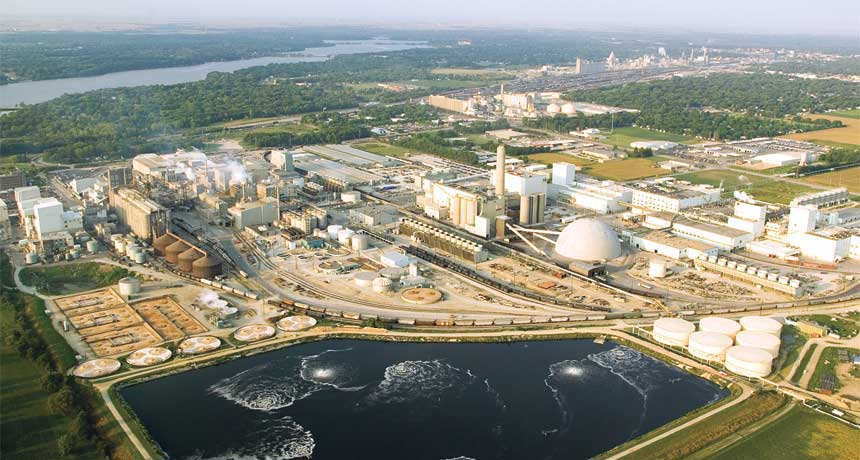
CARBON QUAKES Injecting CO2 deep underground offers a promising way to curb global warming, but the extra pressure may cause faults to slip or fractures to release the buried carbon dioxide.
Archer Daniels Midland
- More than 2 years ago
The shaking in the nation’s midsection has been intense enough in the last few years to break chimneys and scatter dishes. Those alarming earthquakes are in places where such things have been about as common (and as welcome) as laughing hyenas. Their cause: injection of watery waste fluids deep underground as part of natural gas and oil retrieval.
This worries some scientists who have high hopes for a way to curb global warming by getting rid of carbon dioxide that comes from, among other things, combustion of coal, gas and oil. These CO2 emissions may be accelerating Earth toward a climate calamity as the land and seas warm and weather zones shift. One promising strategy for curbing climate change is to pump much of the CO2 from fossil fuel-fired power plants into deep underground storage where everybody hopes it will remain for millennia.
But in an ironic symmetry, in which a proposed solution to a problem shares one of its side effects, deep geological storage of CO2 might produce as many or more quakes than are now being triggered by oil- and gas-related wastewater disposal. Especially if it is performed on the vast scale many hope to see.
To study the basic mechanism involved, scientists are delving deeply into the stresses and strains that have built up over the ages in the Earth’s crust. What they have found is that it is remarkably easy to trigger earthquakes, even in regions that historically have been seismically silent or nearly so.
“We have faults that are accumulating stress over thousands to hundreds of thousands of years, even in Iowa,” says Stanford University geophysicist Mark Zoback. “So when you inject water or gas or any fluid it can set some of them off.”
In the central and eastern United States from 1970 to 2000, geologists recorded a yearly average of only 20 quakes of at least magnitude 3.0 — enough to sway a hanging lamp. Then the count rose: Between 2010 and 2013, 450 such temblors hit — a rate about five times higher than normal for those parts of the country.
Story continues below graph
Human-induced earthquakes
After decades of a steady earthquake rate (dotted line) in the central and eastern United States, activity began to rise in about 2009 and jumped to five times the normal rate by 2013, probably due to human activity.
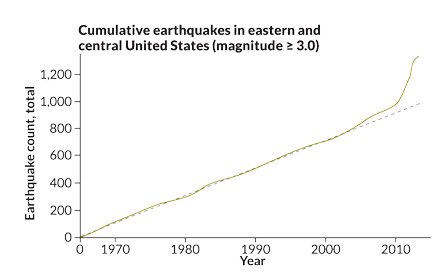
Source: W. L. Ellsworth/Science 2013
If asked to explain the quake upsurge, many Americans may guess fracking. Not quite, but fracking shares a family resemblance to the prime culprit. Formally called hydraulic fracturing, fracking has allowed drillers to make money off sandstones and shales that had been considered too “tight” for the gas and oil to flow freely into wells (SN: 9/8/12, p. 20). Fracking is an old process that has only recently entered wide use. It drives networks of fissures into this type of formation, one patch at a time. It hammers brief pulses of very high-pressure water or other fluids plus grit and chemicals into the shale so that oil and gas can migrate more easily. Fracking is not seismically silent, but its quivers, mostly hovering around or below magnitude 2.0, are imperceptible at the surface.
The immediate reason for the nerve-rattling quakes of magnitude 4.0 or 5.0: New oil and gas fields have gone into production, often after fracking gets them started. Flowing up through the new wells is more than gas and oil. “Flowback” of fracking fluid often comes up too. Plus, a barrel of crude may reach the surface mixed with more than a barrel of additional undrinkable, very salty water that has accumulated down deep over eons.
Industry’s response for many decades has been to gather the foul liquid from many extraction wells and deliver it to a relatively few high-volume wastewater injection sites: More than 1 million wells nationwide send their wastewater to about 30,000 disposal sites. It is typically pumped nonstop and driven at high pressure into deep aquifers a mile or more down to mix with the saline waters already there. In most cases, the water injection works without incident. But at times, “things have gone off the rails,” Ellsworth says (see “When the Earth moves,” below).
For all the huffing and chuffing of heavy equipment for months on end, the energy in these human-made earthquakes does not come from the work being done to shove fluids far underground, Ellsworth says. The potential energy for earthquakes is already down there.
In recent decades geologists have come to suspect that North America’s basement rocks are near the breaking point. Faults, many inactive for thousands to millions of years, lace much of the bedrock and strata all around the globe. In places where such deep, long-immobile faults exist, “it does not take much to set them off,” Ellsworth says.
The zone of unnaturally high pressurization extends well beyond the plume of newly pumped-in fluid. If this high pressure encounters a fault that’s close to failing, even in a layer of rock that is largely impervious to fluid entry, fluid already in the nearby formations may worm its way into the fault zone of crushed rock. It tends to unclamp the fault, lowering its resistance to slippage, perhaps enough for it to yield to the stress it had long withstood.
That is roughly how geologists explain the rise in oil and gas field quakes. They are examples of what is formally called induced seismicity, or quakes triggered by human activity.
Story continues below illustration
Deep storage test
But residents of Decatur, Ill., are not feeling any perceptible quakes. Decatur, a busy industrial town among the rolling hills and cornfields 180 miles southwest of Chicago, is home to the nation’s biggest test of deep carbon storage. Decatur is considered a safe test site in part because no significant fault is anywhere near it.
The North American headquarters and processing plant of the giant agribusiness company Archer Daniels Midland, or ADM, dominates Decatur’s skyline. Trainloads of corn arrive there to become animal feed, cooking oil, corn syrup, sweeteners and more.
The possible escape hatch from global warming under test in Decatur is found in a row of outdoor fermentation tanks, each more than 15 meters high. They turn 3.3 million metric tons (130 million bushels) of ADM corn into 1.3 billion liters of ethanol for blending with gasoline. Leftover mash becomes food for livestock, the used-up yeast fish food. And out the top comes about 2,700 tons per day of nearly pure CO2.
This plant’s CO2 is not part of the world’s CO2 problem in the same way that CO2 from fossil fuel combustion is. The corn as it grew took carbon from the air, so putting it right back as CO2 balances the carbon ledger. Still, to stash such “biogenic” CO2 away permanently offsets some fossil CO2 emissions and, more importantly, paves the way toward isolating CO2 arising from coal and natural gas combustion.
The ADM plant is the centerpiece of a two-phase experiment. The first, the Illinois Basin–Decatur Project, finished a three-year run in November. It sent about one-third of the fermentation CO2 about 2,100 meters underground into a formation called the Mount Simon Sandstone. Named for a hill near Eau Claire, Wis., where it has an outcrop, the formation underlies most of Illinois and rests directly on the continent’s granite shield or basement rock. Money for the recent Decatur test came largely in a $67 million grant from the Department of Energy. Additional funding is from ADM and the carbon services division of the big oil service contractor Schlumberger.
Under a second DOE grant of $141.4 million plus $66.5 million from ADM and other partners, phase two will drill a second well and triple the amount of CO2 diverted down deep. To begin in 2015, that phase should render the plant’s ethanol works nearly free of CO2 emissions.
It is the first major proof-of-concept in the United States for the “S” part of what’s called Carbon Capture and Sequestration (alternatively, Storage). CCS is a central strategy under consideration by climate policy analysts for curbing global warming. Tests of the more challenging job of taking CO2 from the hot exhausts of gas- and coal-fired power plants are under way elsewhere (SN: 9/6/14, p. 22).
Robert Finley, an Illinois State Geological Survey researcher and director of the first phase of the Decatur project, says it illustrates every step of how to bury CO2 deep underground for thousands of years or more. “This is the real deal,” he says. His agency and the USGS maintain seismographic arrays near the well.
So far, ADM has pumped 1 million tons of CO2 into the ground over three years. That may seem like a lot. But it is nothing compared with what will be needed to dent the planet’s greenhouse gas emissions. A million tons of CO2 is about a fourth what the average coal plant emits yearly. The United States has more than 400 coal plants. To reduce American emissions by a billion tons — about 20 percent of the total from all sources including combustion of coal, natural gas and oil — would take thousands of injection facilities like Decatur’s. Annual worldwide emissions from all sources now run at nearly 40 billion tons. About 5.27 billion come from the United States, and fossil fuel-fired power plants account for about 40 percent of it.
In October, just before phase one ended, Scott McDonald, ADM’s biofuels development manager, stands in a cornfield near the plant and points to a fenced enclosure. A concrete lid with some electronic boxes on top covers a monitoring well near the injection site. Inside, geophones — which detect seismic vibrations — dangle more than 1.6 kilometers down. The gear allows engineers and earth scientists to monitor the growth of the underground plume of CO2 — now about 402 meters wide. The detectors map the tiny shudders and other signals of high-pressure CO2 squeezing its way into the sandstone. Inside a nearby shed a monitor displays a series of jagged lines. Earthquakes? “No, that’s just normal noise,” McDonald says. “We get hundreds of seismic signals a month, but not so far today. We never feel them.”
The largest yet recorded was about a magnitude 1.0. “To call these events earthquakes is an overstatement,” says geologist Finley.
Inside the plant’s CO2 compression hall, ear protection is a must. Elaborate plumbing splays across the floor and walls. The place looks a little like the engine room of a large ship. Some pipes have the girth of a horse. Two 2,424-kilowatt, four-stage, six-cylinder reciprocating compressors as big as tractor-trailers dominate the room. Large dehydrators remove water vapor from the CO2. The main pumps and an array of smaller compressors and blowers boost the purified CO2 to 9.8 megapascal pressure at a temperature of 35˚ Celsius. Nearby, a larger hall houses twice as much equipment waiting quietly for the second phase expansion due sometime this year.
Story continues below graph
Shake it up
Several energy technologies have caused quakes of varying magnitudes; oil and gas extraction has caused the most quakes and highest magnitudes. Little data (two events around a magnitude 1) exist on the seismic impact of CO2 injection.
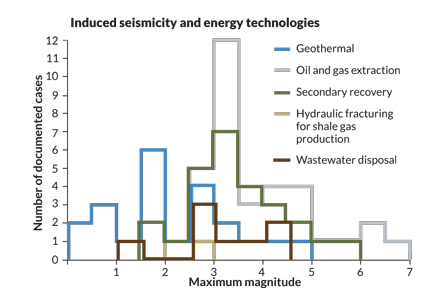
Source: National Research Council 2012
Below the plant, the Illinois Basin’s sediments fill a wide dimple in ancient crystalline granite-rhyolite. The basin spans most of Illinois and much of Indiana to the east and Kentucky to the southeast, plus small parts of Missouri and Tennessee.
As it dives into the basin, the CO2 travels only about 45 meters to reach the deepest freshwater aquifer in the area. Continuing down to 450 meters is a coal seam. At about 600 meters begins the New Albany layer of shale — the first of three caprock layers that geologists say is impervious to any CO2 that might try to work its way back out. A second shale cap, the Maquoketa, lies at around 800 meters. At roughly 900 meters is an oil-bearing shale layer. At 1,500 meters comes the Eau Claire Shale, 150 meters thick and the main seal on the CO2. After that, the well casing enters the 500-meter-thick Mount Simon Sandstone. The final stretch of well casing is 13 percent chrome stainless steel alloy to resist corrosion. A series of perforations let the CO2 out below 2,100 meters. Beneath that the well penetrates the continental basement bedrock of the North American craton, Precambrian granite-rhyolite battered by scars accumulated over billions of years.
The CO2 arrives with a pressure a few hundred pounds per square inch higher than is natural so deep. It flows down the final, 10-centimeter-diameter stretch of injection pipe at about 1,100 liters per minute. To the uninitiated, such injection may seem impossible. Finley shows off pieces of drill core from the Mount Simon Sandstone. Some are crumbly and look porous enough but many are pinkish hunks of rock that look and feel like concrete sidewalk. How can fluids be forced into such sturdy material for years on end?
The reason is pore space, the interconnected gaps between irregularly shaped mineral grains. The Mount Simon formation is about 22 percent pore space by volume. By one calculation, Mount Simon Sandstone has room for at least several centuries of all CO2 emissions from the Upper Midwest. The USGS estimates that it and similar formations around the nation could handle 500 times America’s present annual CO2 emissions.
Hidden faults
Sheer forces from the continental margins are wrenching the Illinois Basin, trying to drag the northern parts to the east northeast and the southern ones to the west southwest. Most of the tiny microseismic events seen since the Decatur sequestration pumps turned on tend to move in directions that relieve this stress — even if movements have only been a few fractions of a millimeter along cracks perhaps 10 meters long. Careful advance scrutiny by state and federal researchers revealed no perceptible significant faults near Decatur.
Microseismicity under Decatur is mostly at or below the boundary of the continental bedrock that begins 76 meters under the injection zone. More buoyant than water, supercritical CO2 has not moved downward, but the pressure clearly has.
So far, it seems, so good. However, some suspect that CO2 sequestration cannot work. A prime reason is that not every injection site, not for wastewater and presumably not for CO2, can be guaranteed to be far from hidden faults.
Stanford’s Zoback says the standard calculations that have convinced some that immense volumes of CO2 can be buried safely in the pore space of deep formations reflect “science that could be done by a fourth grader. They are leaving out one important fact,” he says. “Those pores are already filled with saline water. Where are you going to put that?”
In a paper he coauthored in the Proceedings of the National Academy of Sciences in 2012 and in testimony before Congress, Zoback offered another, larger reason for doubt. He argues that inevitable quakes from CO2 injection, while fairly small, may well open paths, or fractures, through low-porosity caprock. Movement on faults that extend through caprock, he says, could let most of the stored CO2 escape in coming centuries. That would gradually torpedo the point of injecting it.
Story continues below illustration
Pressure concerns
Down deep, where CO2 is injected, high pressure spreads far beyond the injected fluid. As pressure rises, rock grains are pushed apart. This has potential to cause unwanted mechanical changes, including escape of CO2 (through existing or new fractures or leaky faults) as well as quakes due to fault failure.
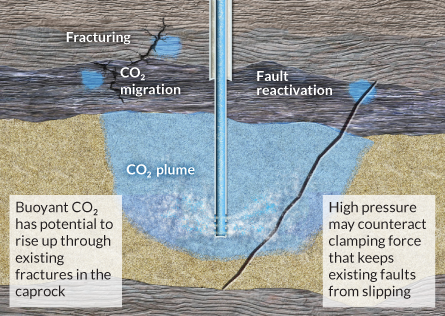
Source: J. Rutqvist/Geotech. Geol. Eng. 2012; Steve Hickman/USGS
Jonny Rutqvist of the Lawrence Berkeley National Laboratory in California and colleagues, in a series of recent papers, have modeled multiple scenarios of how sustained, large-scale deep injections of CO2 might work out. While some earthquakes big enough to alarm local people (magnitude 3.0 to 4.5 at most) appear inevitable, very few would be large enough to damage buildings. Most CO2 for injection could be piped to reservoirs far from population centers. Plus, their studies suggest that if such reservoirs are under several independent layers of impervious caprock, very few if any quakes would open paths for significant CO2 to escape.
It will take a long time, he says, to get a full-scale global sequestration program going, plenty of time for a “learn-as-you-go” approach that could be modified or even abandoned if necessary.
If technical barriers fall and if restrictive regulations or government incentives change and give companies, including operators of gas- and coal-fired power plants, a good business reason to install carbon capture and sequestration equipment, then perhaps CO2 sequestration will become an immense industry in its own right. And perhaps the occasional rumble underfoot may, aside from rattling nerves, be a reassuring sign that humankind is sending fossil carbon in CO2 waste back underground where we found it.
Charles Petit is a freelance science writer based in Northern California.
When the Earth moves
The oil and gas industry operates more than 30,000 deep disposal wells injecting wastewater far below freshwater sources. In addition, many oil drillers increase yield by pumping in high-pressure, near-liquid CO2 that mixes with oil to make the oil flow better. Most of the time it works as planned. But problems can crop up.
Wastewater injection
Rocky Mountain Arsenal, Colo. | 1962–1966
A 3.7 kilometer waste disposal well drilled under U.S. Army supervision was followed by a rising tempo of earthquakes through the mid-1960s; a magnitude 5.0 quake in 1967 broke windows at the arsenal and closed schools in Denver; a magnitude 5.3 quake in August 1967 caused $500,000 in damage in Denver. Once water injection stopped, seismic activity gradually subsided. The episode, followed by experiments at a Chevron oil field in Colorado where scientists could turn quake activity up and down by changing pressure in injection wells, established scientifically that deep fluid injection may lead to earthquakes.
Raton Basin | 2001–Present
Sixteen magnitude 3.8 and greater quakes, including a 4.6 quake followed by a 5.3 six hours later in August 2011, struck after wastewater injections began in oil and gas fields of southern Colorado and New Mexico. Wells in the area inject unusually large amounts of wastewater; two wells about two kilometers from the source of the largest quakes were pumping many thousands of barrels of wastewater per month into underlying reservoirs.
Dallas-Fort Worth, Texas | October 2008–May 2009
A storm of small quakes, mostly of magnitude 3.3 or less, quivered through the region. They all had their origin about 400 meters from a well that started pumping brine into deep formations several weeks before the quakes began.
Prague, Okla.
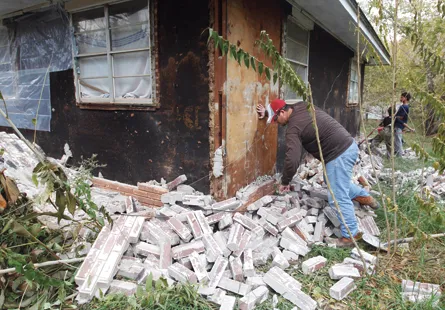
Youngstown, Ohio | December 31, 2011
A magnitude 4.0 earthquake, the first-ever recorded for the community, struck near an injection well shortly after it began pumping.
CO2 injection for enhanced oil recovery
Cogdell Oil Field, near Snyder, Texas | 2006–2011
This area has seen flurries of small earthquakes blamed on wastewater injection. However, a distinct series of more than 90 quakes, 18 with magnitude 3.0 or above, including a 4.4, stands out. It began within two years of the start of deep injection of large volumes of supercritical CO2 and methane to stimulate oil flow. The link to CO2 — or possibly methane — presents a geology puzzle. Similar gas injection in nearby, seemingly identical oil fields was followed by no quake increase. — Charles Petit
This article appeared in the January 24, 2015 issue of Science News with the headline “Carbon Quakes.”






